Z77 mITX Round-Up: Five of the Best – MSI, Zotac, ASRock, EVGA and ASUS
by Ian Cutress on December 31, 2012 7:00 AM EST- Posted in
- Motherboards
- MSI
- ASRock
- EVGA
- ZOTAC
- Asus
- Ivy Bridge
- Z77
- mITX
EVGA Z77 Stinger In The Box
So far in this review the box bundles have been varied. Some have offered a full set of SATA cables, others go for dual antenna for the included WiFi module. As the EVGA has no WiFi module, chances are we will not get an antenna – but one thing to note is that EVGA package their add-ons like no other manufacturer. Each one is sealed in an EVGA labeled plastic bag. While not the most thrilling of results, it must add a little to the cost of the product.
In our EVGA Z77 Stinger box, we get:
Manuals
Driver CD
Rear IO Shield
Molex to 2x SATA Power Cable
Sleeved Molex to 3x SATA Power Cable
4 x SATA Cable

The additional SATA power connectors are a nice touch, but let us look at it from a different angle. No USB 3.0 add-on is included because chances are in this modern era that users will have a case with USB 3.0 ports and they can plug that into the board. Chances are the same users will be buying power supplies with SATA power connectors. It just makes an odd combination to not have one but have the other.
EVGA Z77 Stinger Software
When installing the software for a motherboard, the manufacturer can take multiple routes. Most manufacturers have a one-button install which allows the user to select/deselect what they want installed and then it installs it all-in-one, sometimes with reboots. Other manufacturers only offer a one-by-one route, requiring the user to click through each of the drivers and go through the installers manually, even if the installer does come with a silent mode from the manufacturer (e.g. Realtek drivers). EVGA meet half-way: they use a one-button install which goes through all the drivers, but none of the installs are silent and the user has to sit there for a few minutes (up to 10) clicking Yes, OK or next throughout the whole sequence. Seems a lot of bother given that the software could have just used the silent install switch for everything.
On the driver CD, the option to install the drivers is in the front menu, and the software is in the next.
The sole software that comes from EVGA is the E-LEET Utility.
EVGA E-LEET Utility
Enthusiasts and overclockers will be familiar with the freeware CPU-Z utility. It is used to help identify the system being used, from motherboard to CPU to memory and GPU. It is also used to validate the processor speed when competitively overclocking. E-LEET is essentially a skinned version of CPU-Z, with a few little tweaks.
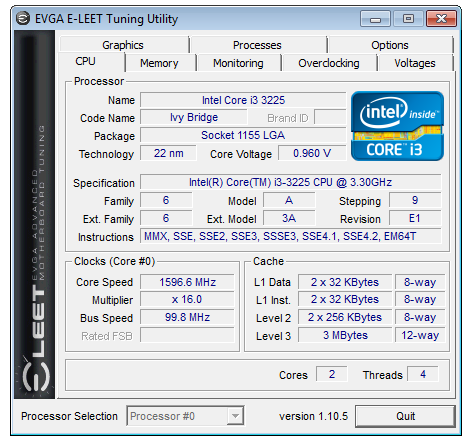
E-LEET gives the option of a few more tabs than CPU-Z does. These are specific to EVGA – we get a monitoring tab for voltages, temperatures and fan speeds:
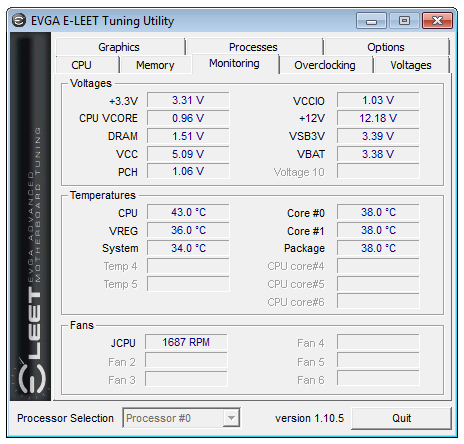
An overclocking tab which allows CPU Multiplier and BCLK adjustment on the fly:

A tab to adjust voltages, also on the fly:
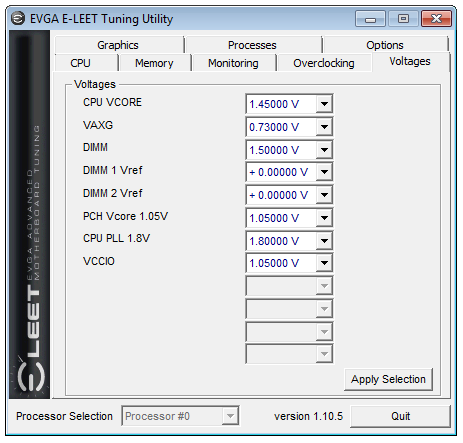
The graphics tab gets a revamp compared to CPU-Z, with options to overclock if you have a compatible graphics card:

A tab for a user to adjust the affinity of certain programs based on a hot-key. This is sometimes useful for overclockers when a benchmark actually decreases in performance when there are too many threads on offer:
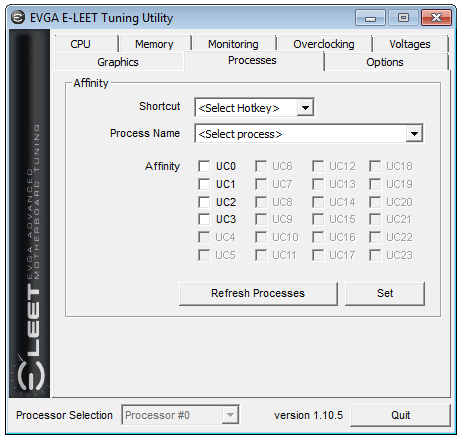
Finally the options menu which allows for a CPU-Z validation as well as saving particular overclocking profiles for various usage scenarios (e.g. downclocking after a benchmark has finished to keep the system stable):



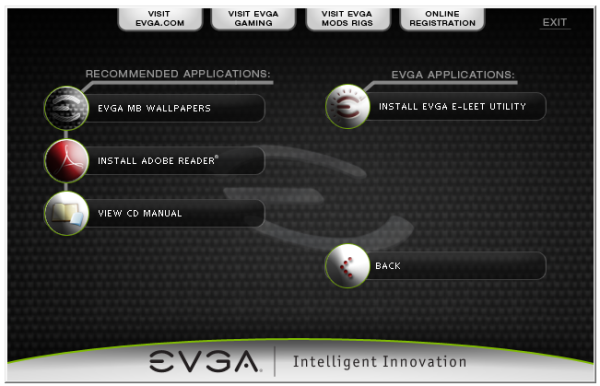
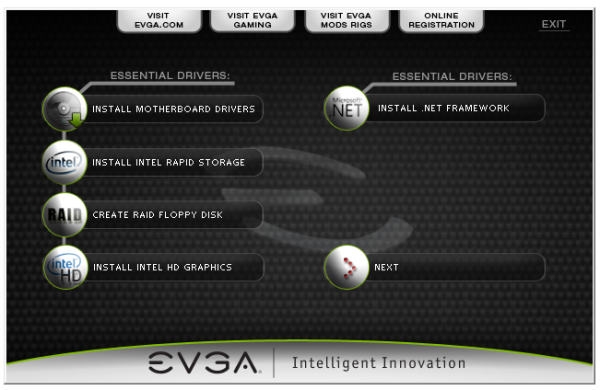














54 Comments
View All Comments
mike_b - Monday, December 31, 2012 - link
Interesting article, but I have to ask why would someone spend more for a Z77 chipset when using 'just' an i3? Surely a much cheaper H61 chipset could do the job admirably, and at much lower cost.Z77 makes sense if you're overclocking, which is excluded from this test...
IanCutress - Monday, December 31, 2012 - link
H61 has no chipset USB 3.0, no chipset SATA 6 Gbps, and you are limited to PCIe 2.0. H61 is also technically limited to one single sided DIMM per channel, and no SATA RAID. There's also SRT to consider, that would be advantageous with the ASRock and the mSATA on the rear.Ian
mike_b - Monday, December 31, 2012 - link
It might make an interesting comparison to see what net advantage is gained with the added features of the Z77 chipset compared with the H61. If budgets are limited the ~100 dollar cost difference between the Z77 and H61 mainboards makes a big difference; that money saved could be put into something which makes more of a performance difference (SSD rather than HDD for example).Anandtech is one of the best tech sites around, you guys do a great job. I do sometimes see though an emphasis on more expensive products when in terms of real-world performance you could get almost the same thing at a much cheaper price. Might be worth mentioning somewhere.
Not least because with yet another new socket coming with Haswell all these 1155 boards will be seen as out of date soon anyway.
IanCutress - Monday, December 31, 2012 - link
Once we get into the swing with Haswell, we will hopefully covering the whole spectrum. Though it is worth noting that motherboard manufacturers, want to put their best foot forward, and would prefer their halo/channel boards get covered before their OEM / low end offerings. Hence this is why you rarely see many mainstream reviews that are not from forums dedicated to the market segment and users testing their own equipment. We are hoping to rectify the balance in due course. If there are any specific products you might want us to test or examine, drop me an email and I'll see what I can put in my schedule (as full as it is[!]) :)Ian
StormyParis - Monday, December 31, 2012 - link
This is a major issue, not limited to motherboards: whenever I'm looking for something middle of the road or outright cheap, I can't find reviews.These Z77 MBs are a nice example: even though I'm recommending/building PCs regularly, most of them mini-ITX, I never came across a use case for Z77. Nobody apart from teens that still have something to prove overclocks anymore. People who want to do multi-GPU get a big case, and a big board. Are we supposed the extrapolate that the makers of good Z77 boards also make good H77 and H61 boards ?
I understand you've got to make do with what you're given by the OEMs. And that reviews was very good, as usual. Pity it is irrelevant ?
Tech-Curious - Monday, December 31, 2012 - link
That's an interesting observation. I have to say, I never noticed a significant lack of coverage for low-to-mid-range components (either in general or on Anandtech in particular), until this Fall, when I was in the market for a lower end motherboard.I guess I just always gravitated to higher end mobos before. Or maybe the coverage for such products was more comprehensive years ago. My memory's foggy, so it's hard to say.
In any case, motherboards appear to be the exception. If anything, I think the internet has generally grown more bullish on low-to-mid-range CPUs and GPUs in recent years (probably, in part, as a result of the stagnating console situation, which results in stagnating system requirements for games).
But all of that rambling aside, yeah. It'd be nice to see more diverse motherboard analysis. When I bought a b75 a couple of months ago, I literally couldn't find a review for that chipset. It wasn't a big deal; it's not like b75's features are any great mystery, after all -- but it is a little nettlesome to trip over sixty bajillion z77 reviews when there's nary peep about any other chipset.
In other news, Ian's review is a good one -- and given that I've been a faithful user of Asus motherboards for the last 15 years, it's nice to see them take home the prize. :)
Etern205 - Saturday, January 5, 2013 - link
My guess would be, why review a cheap board when majority of the readers here won't even bother buying it?And as for Asus boards, I've heard, they do something called based-line features. This means all boards from the bottom of the range to the top (Intel B75-Z77) will have the same base-line features, other features are just added like BT, WiFi, extra lan, etc.
Tech-Curious - Wednesday, January 9, 2013 - link
Yes, I think the issue is that (at least with respect to Intel chipsets) low-end motherboards don't support overclocking. So they're both less interesting to review (fewer measurable differences in performance among different models), and they're less appealing to the presumed audience of sites like Anandtech.Still, the B75 is a perfectly good chipset. If you aren't heavily invested in overclocking, z77's advantages are likely wasted on you. Personally, I'm well beyond my overclocking days; I just don't have the time or the patience to go through the almost endless tuning process anymore. (Even if you find a stable OC at the outset, it can become unstable later, and/or a given application might expose instability that stress testing didn't, weeks or even months down the road).
jonjonjonj - Friday, January 4, 2013 - link
just cause you don't overclock doesn't mean other people don't. why wouldn't you? because you want to get the fastest cpu that you can afford means you have something to prove? some people are just idiots.Zap - Monday, December 31, 2012 - link
But there isn't a $100 difference between H61 and Z77. There is a cheaper Gigabyte Z77 ITX board that's only around $60 more than the cheapest H61 ITX board, and it was even on sale recently for another $13 off making it less than $50 difference.Alternately one can go the H77 ITX route and get all the Z77 goodies except for overclocking, for around $30 less than the cheapest Z77 ITX. I think $30 more than H61 is reasonable for those extra features, plus guaranteed out-of-the-box BIOS support for Ivy Bridge.
I do agree with your (mike_b) first post regarding the choice of CPU used. Ian Cutress, didn't you have a spare K CPU laying around? There are so many people building overclocked ITX rigs these days. I did in a Silverstone SG05 with low profile air cooler to hit 4.2GHz. Plenty of others use the Bitfenix Prodigy and liquid cooling to hit clocks normally reserved for ATX rigs. Another review site (Tweaktown) tested overclocking on Z77 ITX boards and the ASRock hit near 4.8GHz. THAT'S what I want to see.
Of course this AnandTech roundup has some very useful information too, such as DPC latency tests and POST times. Keep up the good work there! But please, know your audience. Next time if the board is supposed to be overclockable, test that feature.
Maybe there can be a companion article about overclocking and heatsink clearance? Would be a shame to not overclock this nice collection of Z77 ITX boards.